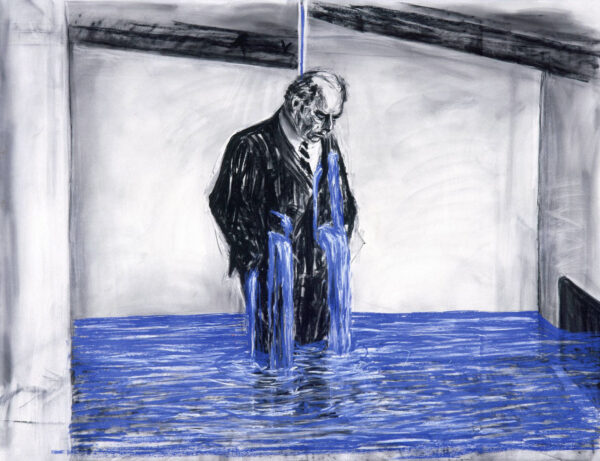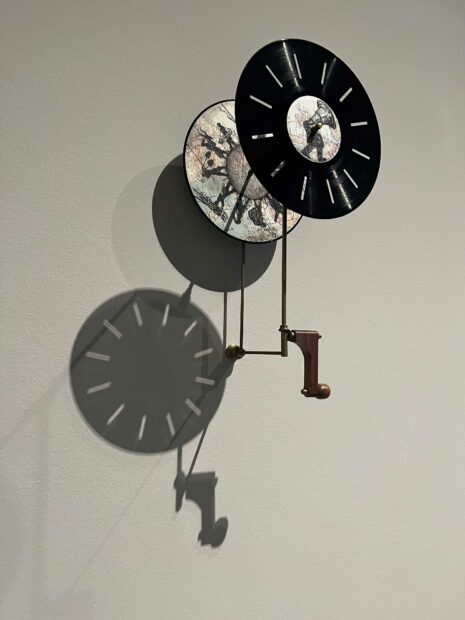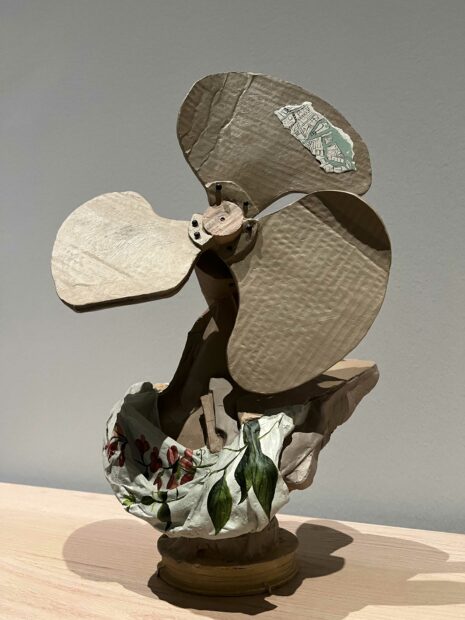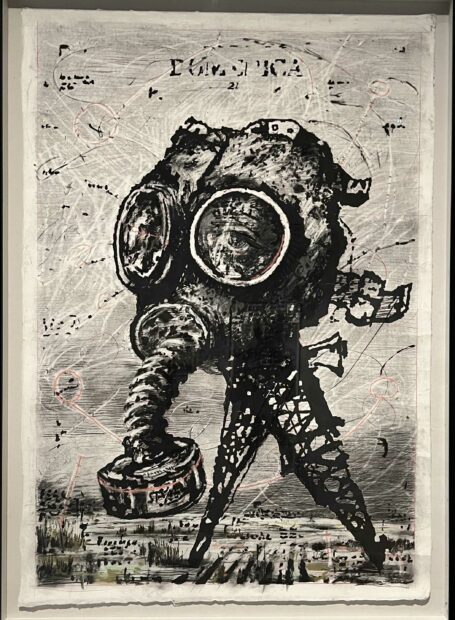
William Kentridge, “Stereoscope,” 1999, 35mm film, transferred to video, The Broad Art Foundation, Los Angeles ©William Kentridge
The prolific output of the artist William Kentridge is easy to admire. His confident hand abounds with life in his drawings, animations, and sculptural works. His expressionist tendencies are apparent in early large prints included in his retrospective exhibition, William Kentridge: In Praise of Shadows at the Museum of Fine Arts, Houston, and the trajectory from static drawings towards stop motion magic is explained in the astute curation of the show. It is one of the strongest displays of artistic vision on view in recent memory.
Kentridge is originally from Johannesburg, South Africa. His body of work is an evolving reckoning of sorts, grappling with historical import in a personally open and melancholic manner shaped, no doubt, in large part by his family of origin’s deep roots in the anti-apartheid movement. Kentridge also has early roots in the theater; he worked at the Junction Avenue Theatre Company, which was an interracial organization, while attending the University of the Witwatersrand in the 1970s. This link between the kinetic image and the fixed drawing is precisely where Kentridge shines most brightly.
Greatly influenced by the eponymous In Praise of Shadows, by Jun’ichiro Tanizaki, Kentridge’s technique of a combination of additive and subtractive charcoal rendering, captured in still frames and then projected in video, pervades a mood celebrated in the book — one of the “mystery of shadows.” Of course it is the mysteries of the apartheid legacy that Kentridge is grappling with.
His figurative works are so deftly handled in charcoal, so “lived in,” that they only grow in intensity when the viewer is allowed to see the drawings morph and repeat in messy erasures and inclusions as documented in their stop motion sequencing. The passages of transition from one subtle movement to another — one character’s mere glance from here to fro — becomes imbued with emotion and process via ancillary mark making. The residual charcoal strokes from previous iterations are never really erased, never expunged entirely, leaving a sort of living record of the drawing’s past, and in some sense, utility.
Several displayed drawings will have been worked and reworked and documented in sequence in various projections in the show, and to be sure, these hit the nail squarely on the head when it comes to a synergy reached between form and content. Indeed, in one piece the artist employs video imagery manipulation into the frame, a conceptual misstep perhaps, losing a purity while gaining little.
Kentridge glides seamlessly between mediums, his background in theater a touchstone throughout his career. He is the type of artist that won’t rest until he’s found the right voice for what he’s contemplating. It’s a dogged process that is on display in voices ranging from gorgeous large-scale prints to caste bronzes emulating convincing cardboard assemblages to stop motion stories unfolding in sublime patterns before one’s eyes.
This evidence of determination makes one think deeper about the images in the exhibition. They speak of an enduring process, literally and metaphorically, in a way that honors the generational burden of apartheid and its import to those who suffered under it, as well as those who enforced it. Even the small and deceptively simple bronze sculptures in the show pack a punch with their trompe l’oeil presence. Indeed, Kentridge “enhances the beauty of…” human struggle by giving it voice in the very process of his art. It is not that what he is saying is so profound or original, rather it is the passion and expression through which his labor has been allowed to mature as a representative voice amidst all of the systemic horrors it references. His art has clearly been forged in human struggle.
One of the many standouts in the show includes Singer Trio (2019), a “singing” collection of three Singer sewing machines aligned atop a mounted mechanism which allows their fashioned conical speakers to rotate and perform in a Jean Tinguely-like manner. The craft here, as in all of Kentridge’s work, is impeccable yet not belabored. The artist’s aesthetic reminds one of Marlene Dumas, another South African heavy, in that his results are seemingly loose, interpretive, expressionistic. And they are, to be sure, but they also appear effortlessly perfect, bespeaking necessity with each iteration.
Kentridge’s art presents an honest reflection of the process by which it was made, and this in turn projects a comfortableness in the work, a readiness to forego abstractions of politics in favor of the humanity in reconciliation. Naturalistic might be a way to put it, but that’s not quite accurate. Here there is conscious manipulation, an acquiescence towards the necessity of strife. It is the messiness of a construction site, rather than the austere cleanliness of a blueprint.
There are no grand epiphanies arrived at in Kentridge’s art, rather the whole process of image making, static, kinetic, or otherwise is the epiphany. As we try to come to terms with the ghosts of our past, we do so through acts of reconciliation, which are by themselves inadequate deliverers of redemption. But they do give evidence of the work involved in the attempt, and that can be quite revelatory in and of itself.
This exhibit resonates even more intensely given the congruent show, Pipilotti Rist: Pixel Forest and Worry Will Vanish (through September 4, 2023), on view in the MFAH’s Cullen Hall. While Kentridge’s exhibition inspires introspection and cultural reflection, Rist’s comes off as an impromptu DJ booth writ-large with requisite bean bags included, a sure sign the establishment is hip. Rist’s installation is another in a long list of shows that market well on Instagram, but offer little else in return. Kentridge’s In Praise of Shadows maintains interest long past the selfies.
William Kentridge: In Praise of Shadows is organized by The Broad, Los Angeles and its curator, Ed Schad. The Houston presentation is organized by Alison de Lima Greene. The exhibition is on view at the Museum of Fine Arts, Houston through September 10, 2023.





